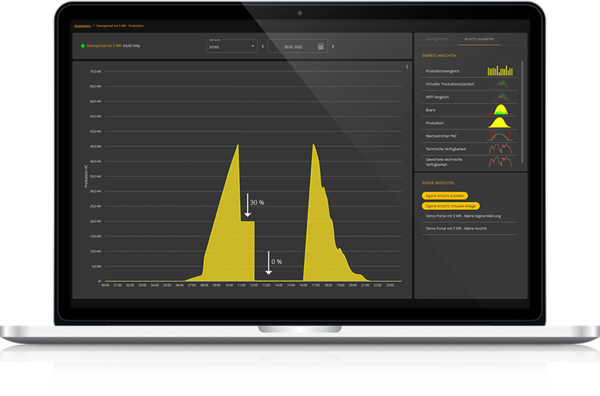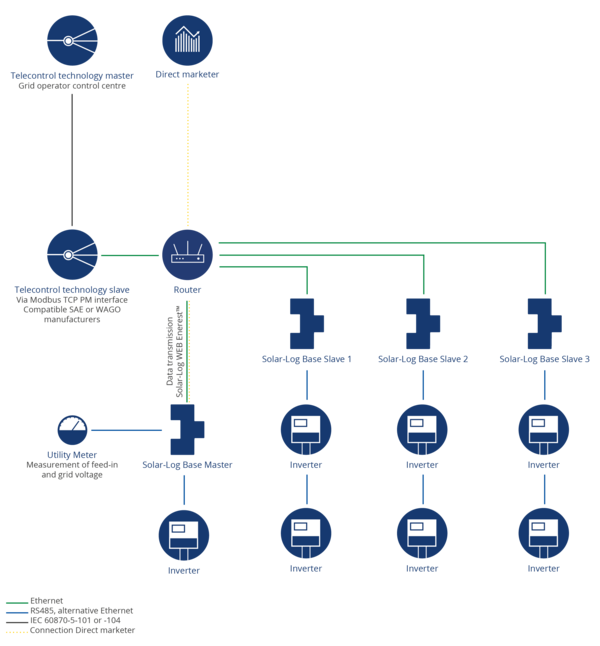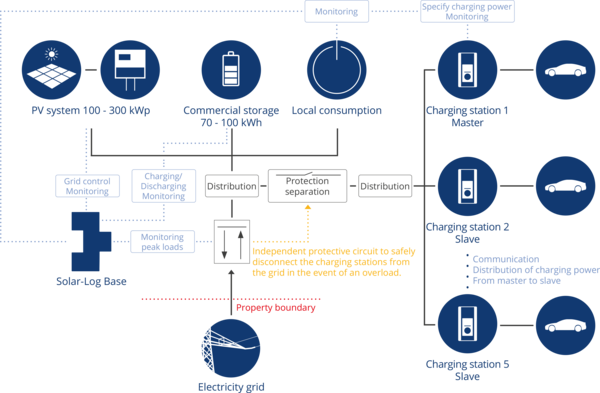A complex challenge Feed-in management and peak shaving
by Vivian Bullinger | 08.01.2024
The electricity grid used to be a one-way street from a few large central power plants, whose energy flowed to many consumers. Today, consumers have become so-called prosumers (producers and consumers) who both purchase and feed in electricity. The increase in generation plants has made the core task of grid operators - maintaining grid stability - more complex. Feed-in management is required to ensure that the interaction between the decentralized prosumers functions smoothly and grid stability is maintained. In addition to this, peak shaving plays an important role in avoiding load peaks and thus contributing to grid stability.
In our blog post, we show various solutions for solving the challenges of feed-in management and peak shaving.
- Simple feed-in management - limited feed-in (x %)
- Interconnected control - PV power plants
- Load peak management (peak shaving)
- Peak shaving combined with e-mobility
1. simple feed-in management - limited feed-in (x %)
The regulations and requirements of feed-in management differ in their complexity. As a rule, this means that the larger the system, the more complex the requirements that the system must fulfill. These requirements are implemented with the help of energy management systems, such as the Solar-Log energy manager.
Simple feed-in management with x % control means that the system automatically regulates itself to x % of the system output. This measure ensures that too much electricity does not flow into the grid in the event of an energy surplus, resulting in an overload. This measure can be implemented in very different ways, from direct x-% specification via control devices of the grid operator to independent regulation to x-% at the grid connection point, taking into account production and local consumption. The latter has the advantage that it covers the local energy demand in the best possible way with locally produced energy and thus relieves the grid not only in terms of feed-in, but also in terms of consumption.
 Figure 1 - Feed-in management means the controllability of decentralized generation systems. There can be different levels of control. As can be seen in the picture - e.g. a reduction to 30 % or even 0 %.
Figure 1 - Feed-in management means the controllability of decentralized generation systems. There can be different levels of control. As can be seen in the picture - e.g. a reduction to 30 % or even 0 %.
A central function of the energy management system is therefore to limit the x % feed-in to the grid. Fixed or dynamic power limits are now prescribed in many countries. This limit can be set flexibly for different threshold values. This means that different requirements (70 % regulation, 50 % or 60 % regulation with storage support, 0 % regulation in Spain, etc...) can be met.
In practice, a bidirectional measuring device is usually installed for this purpose, which records the energy flows at the grid connection point and transmits this information to the energy management software (EMS). A controller responsible for the EMS evaluates this information and regulates the energy flow from the local photovoltaic system, for example.
However, it can also happen that the grid operator sends a control specification via its control devices and regulates the system to this value. Depending on the size of the system and the installation location, the specifications can vary greatly, just as the grids have grown historically.
 Figure 2- Structure of an x % feed-in control for PV systems with the Solar-Log energy management system.
Figure 2- Structure of an x % feed-in control for PV systems with the Solar-Log energy management system.
2. interconnected control - PV power plants
The larger the PV system, the more complex the implementation of feed-in control becomes. The demands on the energy management system (EMS) increase, especially in PV power plants where many inverters come together.
In order to reliably implement feed-in management for systems of this size, several energy management devices are linked together via an Ethernet network. This networking allows the control signals of the grid operators to be exchanged with each other.
With Solar-Log, such complex architectures can be implemented using the network control principle. Here, the signals from the grid operator are received at the master EMS and distributed to the connected inverters via the slave EMS. For this system architecture, the Solar-Log system allows the master to be linked with up to nine slaves in the network. By networking the EMS, complex requirements (several system parts and feed-in points and many different inverter manufacturers) can be implemented.
By using the interconnection control license, it is also possible to split up the system for direct marketing. By using slave devices, the system is divided into areas. A separate direct marketer can then be selected for each area. Any reduction commands from the direct marketers are prioritized with the commands from the energy suppliers and documented accordingly.
 Figure 3-Connected control for feed-in management for PV power plants.
Figure 3-Connected control for feed-in management for PV power plants.
3. load peak management (peak shaving)
One area of energy management that is becoming increasingly important with the ongoing expansion of renewable energies is peak shaving.
Most companies have a very high demand for electricity due to a large number of consumers (machines, heat pumps, vehicle fleet). This is increasingly being covered in full or in part by PV systems and battery storage. However, companies also have another problem. Due to the high number of consumption points, the base load that these consumers permanently draw from the grid is very high. In addition, high consumption peaks or load peaks can occur due to switch-on processes or the temporary operation of other consumers. In order to be able to handle these load peaks, capacities must be kept available in the energy grid infrastructure, which is cost-intensive. The efficient handling of load peaks is therefore important in order to ensure the stability of the electricity grid, avoid overloads and optimize energy costs.
There are various options for capping or avoiding these load peaks. One option is the intelligent use of PV energy together with battery storage, which is coordinated by an energy management system. The energy management system, e.g. from Solar-Log, caps the peak loads (peak shaving) by effectively controlling the PV system and the battery storage. It therefore ensures that the additional electricity required for peak loads is not drawn from the power grid, but from a battery storage system.
4. peak shaving combined with e-mobility
Peak shaving and e-mobility are two concepts that can be combined to improve grid stability and better manage demand during peak times.
The energy management system already ensures that the PV system is used in conjunction with a corresponding battery storage system to reduce the connected load at the grid connection point and avoid peak loads. Electric vehicles can also be integrated into this intelligent charging management system and controlled in such a way that they are preferably charged at times of low load. This helps to distribute the additional energy demand from electromobility and in turn avoid peak loads.

A perfect team - for more growth
The interaction between feed-in management and the energy management system (EMS) is crucial for the efficient use of renewable energy. Feed-in management regulates the feed-in to the electricity grid by optimizing the production of renewable sources. At the same time, the EMS integrates energy management strategies to control consumption. By precisely monitoring production and consumption, the system enables prompt adjustment. The result is a balanced grid that minimizes peak loads. Seamless interaction between these subsystems promotes grid stability, optimizes energy efficiency and facilitates the integration of renewable resources into energy management.